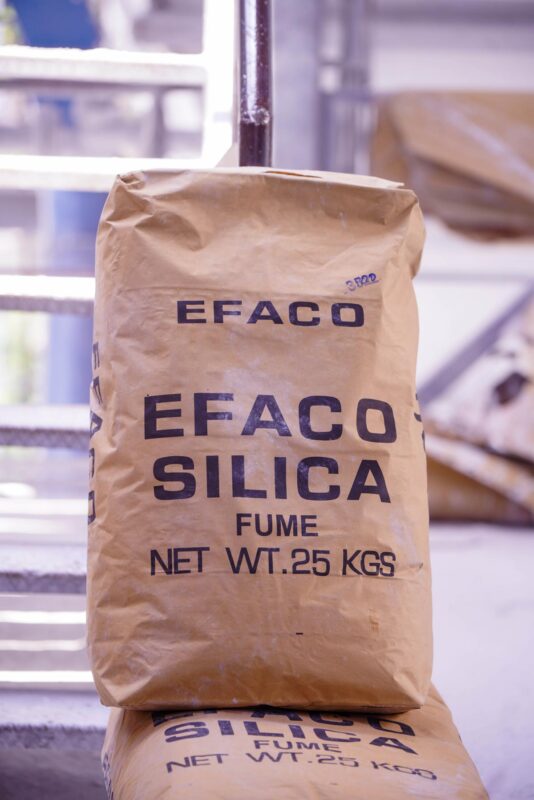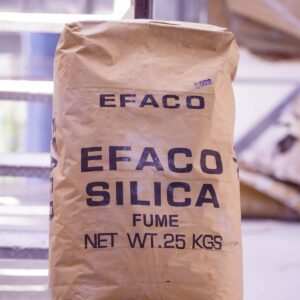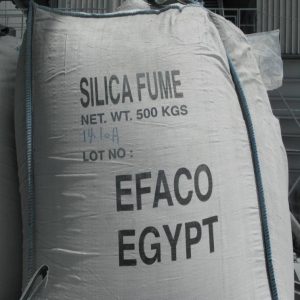Silica fume
Silica Fume is a by-product of large-scale industrial processes, generated from gas purification units from heat emissions rising during the process of producing ferrosilicon alloys. Silica fume is formed after condensation and precipitation. Therefore, this material is called by some specialists micro silica, which is a super-fine powder. This material is mainly used in Self-Compacting Concrete (SCC) which is used in challenging large facilities. Silica-fume concrete is highly resistant. Silica Fume fills the gaps in all parts of the molds and provides an excellent appearance in addition to its distinguished characteristics.
- Registered with Egyptian Standard No. (5129-1) of 2006.
- Conformity to American Standard No. 1240 of 2004
Specifications: –
- Extreme fineness (1.0 microns).
- Spherical shape and non-crystalline glass composition.
- A high content of silicon oxides up to (97%).
- Silica fume is a very reactive pozzolanic material when added to cement.
The most important advantage of concrete upon the addition of silica fume as per the type of mixture used
-
Improvement of physical and chemical properties of concrete mixture, whether it is in the quasi-solid or solid state.
-
Silica fume particles have a smaller particle size than cement by about 100 times. Thus, it fills the voids between the particles of cement, reducing permeability rates, which works on the formation of a dense and coherent concrete mixture leading to increases in the rate of pressure resistance to (1000 kg / cm3).
-
It prevents water permeability because it has a high affinity to water absorption.
-
It prevents concrete carbonation which is the main corrosion reason of the reinforcing steel.
-
It prevents off-white discoloration of concrete surfaces because they react with the hydrated Lime to produce the hydrated calcium silicate.
-
Fume silica concrete has a greater resistance to penetration to chloride ions of concrete.
-
It increases the resistance to bending and tensile strength which is up to 30%.
-
It provides effective resistance against chemicals and solvents.
-
Silica fume concrete is more resilient to shocks and loads than ordinary concrete.
-
Due to the significant decrease in the permeability of Fume silica concrete, it has been proven effective when used in water installations and bridges.
Proportions of silica fume additive to cement weight
- From 5% to 8%: in the high resistance concrete, especially in warm weather environments.
- From 10% to 15% of concrete used below the water level.
- From 2% to 5% on concrete pumping with the cement
Silica Fume applications can also include, but are not limited to:
- Packaging of the granulated chemical fertilizers (as it increases the density of fertilizer granules and prevents ossification)
- Manufacture of paints.
- Manufacture of plastic and nylon.
- Manufacture of adhesives (silicone).
- Product input of many chemical preparations.
Some companies and institutions to which we export silica fume:
- Tomai Japanese Co.
- Norwegian Alcom Co.
- Dynamic / TRO-PAK German Co.
- Danish BH Co.
- Grecian Magnesite S.A.
- Mahakoshal / Oriental / Jenny Indian Co.
- Jordan Japanese Fertilizers Co.
- Arabian Trading Establishment in UAE.
- R.B. Mineral Corporation.
Some companies and institutions that use EFACO products in the A.R.E
- Egyptian Company for Prestressed Concrete (ECPC)
- Petrojet (Ismailia Tunnel Project)
- Orascom.
- Sika Egypt.
- Asfour For Mining & Refractories.
- MR. Chemicals Co./ BASF Chemicals.
- French Co. (Subway).
- CEMEX Ready Mix.
- Arab Contractors Company.
Technical specifications for Silica Fume
| chemicals specifications and physical properties of Microsilica | ||
|---|---|---|
| Chemical Analysis | Ⅰ | Ⅱ |
| ≥ 92 | 90--92 | |
| SiO2 | 92.0 MIN | 90.0 MIN |
| Al2O3 | 1.0 MAX | 1.0 MAX |
| CaO | 0.8 MAX | 0.8 MAX |
| MgO | 1.0 MAX | 1.0 MAX |
| Na2O | 0.8 MAX | 0.8 MAX |
| K2O | 1.5 MAX | 1.5 MAX |
| C | 1.5 MAX | 1.5 MAX |
| SO3 | 0.5 MAX | 0.5 MAX |
| CL | 0.15 MAX | 0.15 MAX |
| L.O.I | 3 MAX | 3 MAX |
| Moisture | 0.5 MAX | 0.5 MAX |
| Physical Properties | ||
| Sizeabove45um | 3.0 MAX | 3.0 MAX |
| Bulk Density | (200—400)kg/m3 | (200—400)kg/m3 |
| (BET) Particle Surface Area | 15.0 m2/g Min | 15.0 m2/g Min |






